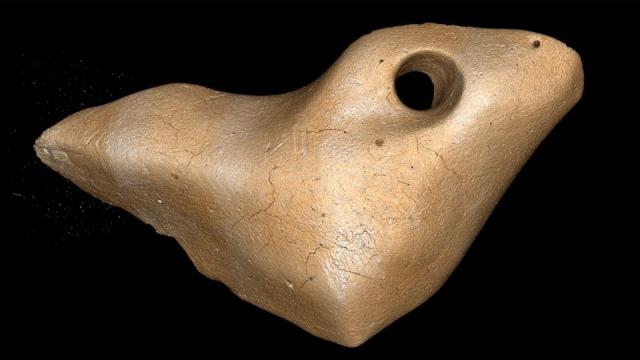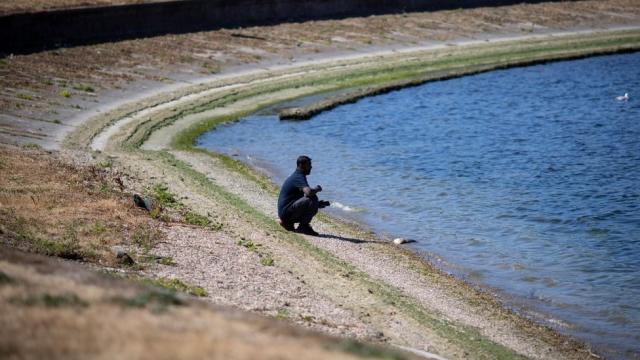Science Daily News | 13 Jul 2023

Views (106)

Thames Water: Warnings London may face water rationing 'imminently'
A leading environmentalist tells City Hall streams that provide London with water are drying up.

London could face water rationing "imminently" because of over-abstraction, over-use and wastage through leaking pipes.
Environmentalist James Wallace, chief executive of River Action, made the warning at a meeting with the Greater London Authority (GLA).
He said the chalk streams that feed the capital's water supply were drying up.
London's main water supplier Thames Water said there needed to be a national change in how water was used.
The company also said it had no plans to ration usage.
"This means that we are going to be seeing rationing of water in north London imminently. We're not talking 20, 30, 40 years," he said.
"When are we going to treat this like it's an emergency?
"I appreciate it takes time to dig a reservoir but some of these things, like changing our abstraction requirements, reducing consumer demand, fixing leaky pipes, this is a national crisis and we need to address it that way."
However, the company's interim chief executive, Cathryn Ross, told the GLA that one-third of this quantity was actually "unmeasured consumer use" rather than loss through holes in the company's pipes. She added that rolling out water meters would mean customers could be billed more accurately.
In answer to a question about managing water resources, she said: "Yes, there is more we need to do.
"But we actually need to change our national conversation about water, we need to change how we think about water.
"We need to understand, for example, that London has more or less the same rainfall as Jerusalem and we're not living in a wet country where we can take water for granted."
The BBC asked Thames Water about this comparison between London and Jerusalem. The company said it was not something it took lightly and that it had made the claim before.
According to the Met Office data gathered from Kew, south-west London, the capital has an average of 627mm of rain annually. In comparison, the centre of Jerusalem sees an average of 522mm of rain each year, according to the Israeli Met Service.
The Met Office also said Jerusalem sees no rain during the summer while London gets rainfall all year round.
Ms Ross said 80% of Thames Water customers already used the government's target of 110 litres a day but that 20% used a lot more, mostly for watering gardens.
She said the company had wanted to ease supply issues by building a 150-billion-litre reservoir in Abingdon, Oxfordshire.
The project has faced local opposition.
Ms Ross admitted that many of the company's pipes were "ageing assets" that should have been replaced but that the cost could not be covered by customers. Thames Water later said that was due to rules around how consumers are charged.
Thames Water, along with other companies, has promised to update its infrastructure to reduce sewage discharges, but it has spent the past few weeks fending off speculation about its financial collapse and nationalisation because of a £14bn debt pile.
In response, a Macquarie spokesperson said: "We supported the company as it delivered record levels of capital investment in its network, helping to reduce water leakage by 22% while keeping customer bills amongst the lowest in the country."
Thames Water is currently owned by a consortium of foreign pension funds and sovereign wealth funds.
Thames Water failed to meet its target this year on reducing leakages as well as those for sewer flooding, pollution, blockages and customer usage.
Ms Ross said the company was not profitable and this year made after-tax losses of £30m.
She declined to offer a view on whether privatisation had been a failure, saying she had not "given much thought" to whether the water industry would be in better shape if it had remained publicly owned.
Why is Earth's day 24 hours long (and how did the sun keep it from being longer)?
Thermal tides in Earth's atmosphere have counterbalanced gravitational tides from the moon, bringing a pause to the slowing down of Earth's rotation.

The length of Earth's day is only 24 hours, rather than over 60 hours, thanks to a temporary balance between the gravitational tidal forces from the moon and the sun.
As we know, the moon's gravity pulls on Earth's oceans, resulting in high tides on opposite sides of the planet as the ocean bulge follows the moon around our planet. More mass in the ocean tidal bulge means the moon's gravity pulls on it more, and, coupled with the effects of friction between the ocean tides and the sea floor, the end result is a slowing of Earth's spin by about 1.7 milliseconds each century.
However, thermal tides in Earth's atmosphere are able to counteract this breaking effect if the period with which they reverberate around the planet enters into a resonance with Earth's rotation. The temperature of the atmosphere controls the velocity of the thermal waves, and as the atmosphere warms, it swells, creating another kind of bulge.
For most of Earth's history, the lunar tides have been 10 times stronger than the thermal tides, resulting in Earth's rotation slowing down. However, based on atmospheric global circulation models and geological evidence of bands in sedimentary rocks corresponding to spring and neap tides in the past, this all changed between 2.2 billion and 600 million years ago.
As the atmosphere warmed (as evidenced by the lack of glaciation during this period), the thermal tides grew larger and faster until they entered a resonant frequency with Earth's rotation. A resonance is a kind of amplification. The common analogy is a child on a swing — give them a push at just the right time, synchronous with the arc of their swing, and they swing faster and higher. Something similar happens with resonances in nature.
RELATED STORIES:
Consequently, the slowing down of Earth's rotation by the moon's tides began to be counterbalanced by the speeding up incurred by the thermal tides. For that long period of time between 2.2 billion years and 600 million years ago, Earth's length of day did not continue to slow, but remained at 19.5 hours.
Eventually, the two tidal forces moved out of sync, and over the past 600 million years Earth's rotation has subsequently begun slowing down again. Today, the length of day is 24 hours, while the thermal tides take 22.8 hours to travel around Earth.
"As we increase Earth's temperature with global warming, we're also making this resonant frequency move higher — we're moving our atmosphere farther away from resonance," said Murray. "As a result, there's less torque from the sun and therefore the length of day is going to get longer sooner than it would otherwise."
See amazing images from James Webb Space Telescope's 1st year gazing deep into the cosmos (photos)
The James Webb Space Telescope, humanity's most powerful eye in the sky, has captured some remarkable images in its first year of gazing deep into the universe.

The universe has never looked this gorgeous.
The first images from NASA's James Webb Space Telescope (JWST) were released July 12, 2022. In the year since then, the deep-space imaging probe has captured some of the most remarkable stellar photography humanity has every laid eyes on.
As the James Webb Space Telescope celebrates one year of science, we've collected some of the most breathtaking images of the universe produced by the revolutionary instrument.
JWST's near-infrared camera (NIRCam) contains a special lens which allows mission operators to inspect and align sections of the telescope's primary mirror.
Instruments aboard the spacecraft are so sensitive that the heat and electricity from any type of onboard observational cameras would have created interference. So, aside from the image of a folded-up JWST floating away from its launch vehicle's payload bay, these black and white mirror selfies are our only images of the telescope in space.
However, the telescope's enhanced capabilities compared to its predecessors lends its images levels of detail unprecedented in other space telescopes.
The lopsided ice giant has the most erratic orbit of any planet in the solar system, and a ring system that might rival of Saturn's if it were close enough for better viewing.
RELATED STORIES:
This was another of JWST's first released images and arguably its most well-known.
Building blocks of Mars life? Perseverance rover digs up diverse set of organic molecules on the Red Planet
NASA's Perseverance rover has found an intriguing menagerie of organic molecules in a Martian crater, but their source remains unclear.

NASA's Perseverance rover has found a diverse menagerie of organic molecules in a Martian crater, a new study reports.
"They are an exciting clue for astrobiologists, since they are often thought of as building blocks of life," study lead author Sunanda Sharma, a planetary scientist at the California Institute of Technology in Pasadena, told Space.com.
"As planetary scientists and astrobiologists, we are very careful with laying out claims — claiming that life is the source of organics or possible biosignatures is a last-resort hypothesis, meaning we would need to rule out any non-biological source of origin," Sharma said.
Specifically, the scientists examined data from the Scanning Habitable Environments with Raman and Luminescence for Organics and Chemicals (SHERLOC) instrument onboard Perseverance. SHERLOC is the first tool on Mars capable of conducting fine-scale mapping and analysis of organic molecules.
The researchers focused on SHERLOC data from Máaz and Séítah, two rock formations on the Jezero Crater floor. When ultraviolet light from SHERLOC illuminates organic compounds, they can glow much like material beneath a blacklight. The fingerprint of wavelengths in the glow from a molecule can help identify it.
RELATED STORIES:
The scientists discovered evidence of many different classes of organic molecules. These occurred in a variety of patterns in space within Máaz and Séítah, suggesting they might have originated from a number of different minerals and mechanisms of formation. These organic compounds mostly appeared connected to minerals linked to water.
"Seeing that the possible organic signals differ in terms of type, number of detections and distribution between the two units of the crater floor was surprising and exciting," Sharma said. "That opens the possibility of different formation, preservation or transportation mechanisms across the crater and, more broadly, the surface of Mars."
Pollution: Separate plastic waste to help make a prosthetic leg
People are being asked to separate their plastics so they have a better chance of being recycled.

Sorting rubbish from recyclables could be seen as a bit of a hassle, but separating different types of plastic in your bin could help provide a person with a prosthetic leg.
A new scheme is making that happen by reusing unwanted plastic rather than it being sent to landfill.
Precious Plastics is launching a project in Conwy and Rhondda Cynon Taf to help reduce plastic waste.
The Welsh government has set a target of zero waste by 2050.
The project makes different plastics into a variety of objects, so the hassle is worth it.
Prosthetic legs can be made out of oil bottles, cabins and chess boards out of bottle caps, and tote bags can be created from plastic bags.
Eifion Williams, chief officer of conservation group Circular Communities Cymru, said that getting the most out plastics is the big challenge in creating a circular economy - where materials are reused and not thrown away.
"There are seven different types of plastic and if they get compounded and made into a mixed compound it's very difficult to untangle that," he said.
"It's very expensive too, so if we can keep those polymers separate in the same way as we keep our paper, tins and glass separate then we will be making steps towards the circular economy."
Precious Plastics is a community based scheme which gives villages and towns an opportunity to join the movement.
Mr Williams said it was not a case of "just telling people to do recycling because it's the right thing to do, this is giving them tangible benefits in their hands".
Andromeda Thomas is the coordinator of the environmental group Crop Cycle Treherbert, which shares a site with Precious Plastic on land previously used as a petrol station in the heart of the town.
"I think people here can see things actually being put into action now, which is really good," she said.
"I think there's always a long way to go and there's always room for improvement, but this could act as an example to other people and at the same time we can explore different ideas and move things forward."
Gwynfor Jones, 18, started as an apprentice at the Crop Cycle scheme and he is now the youngest member of staff.
"Before this project came I thought a milk bottle was one plastic but no, with the lid being a different colour, shows it's a different plastic than the actual bottle itself.
"So you can get plastics with three, four different types in one object."
At the Nantycaws recycling centre, near Carmarthen, a new re-use project called Canolfan eto is also helping to deliver a circular economy throughout the county as well as becoming a leader in recycling and re-use in Wales.
The aim is find new uses for unwanted items that have been thrown away.
Customers can buy items including furniture, paint, bicycles, gardening items and much more.
It is hoped that schemes such as Precious Plastic will help ensure that Wales reaches its ambitious target to achieve zero waste by 2050.
Based on the latest comparable international information to hand, Wales is third in the world when it comes to its recycling performance, behind Germany and Taiwan.
Wales' recycling efforts save about 400,000 tonnes of CO2 per year from being released into the atmosphere.
The Welsh government acknowledged the need to do more and said it would soon introduce workplace recycling regulations, a ban on single use plastic and extended producer responsibility.
Ancient pendants made from giant sloth bones suggest humans were in Americas earlier than thought
An unprecedented discovery made by archaeologists working in Brazil is shaking up what we know about the first inhabitants of the Americas.

An unprecedented discovery made by archaeologists working in Brazil is shaking up what we know about the first inhabitants of the Americas.
Three giant sloth bones found at Santa Elina rock shelter in central Brazil were likely perforated and polished by human hands in order to be used for personal adornment — probably as pendants, according to a new study.
The pendants — thought to be between 25,000 and 27,000 years old — are the oldest known personal ornaments unearthed in the Americas and the only ones known to have been made from giant sloth bone in the archaeological record, according to paleontologist Thais Pansani, lead author of a new study on the artifacts. She is a postdoctoral researcher in ecology and natural resources at the Federal University of São Carlos in Brazil.
The three sloth-bone pendants were among thousands of osteoderms — bony plates embedded in the sloth’s skin similar to an armadillo’s scales — found at the rock shelter that belonged to an extinct species of giant sloth known Glossotherium phoenesis. The site also features rock art of animal and humanlike forms, although the exact age of the panels is still unclear to scientists.
Senior study author Mírian Pacheco, a professor and researcher at the Laboratory of Paleobiology and Astrobiology at the Federal University of São Carlos, said that the artifacts “present a very suggestive shape of pendants, mainly due to the polishing and the location of the hole.”
The team analyzed the three modified and unmodified osteoderms and performed experiments on some of the fossilized bones and their closest modern analog — armadillo osteoderms — to understand how the pendants were made, Pacheco explained. Microscopic marks revealed that they were polished by human hands before the bones were fossilized, she said.
Pacheco said she believed humans and giant sloths coexisted at the site. A herbivore with long clawed arms designed for digging, the creature would not have preyed on humans.
“Although they had a low metabolism, they were agile animals that walked predominantly on all fours, although they could stand up (mainly to get food from trees). We cannot say if humans saw these animals as threat,” Pansani said via email.
The pendants haven’t been directly dated because the researchers didn’t want to damage the extremely rare artifacts.
However, Pansani said the team dated other material — sediment, charcoal and other giant sloth bones — from the same layer as where the artifacts were recovered.
“All these dates agree with ages between 27,000 and 25,000 years ago, so we can infer that the age of the artifacts is in this range,” Pansani said.
North and South America were the last continents to be inhabited by modern humans, but exactly when that started is a topic that has divided archaeologists. Many experts are skeptical that humans occupied the Americas any earlier than 16,000 years ago, the study noted.
“The confirmation of the age of these artifacts from Santa Elina strengthens the hypothesis of older human occupations in the Americas,” Pacheco said.
For the new study, Pacheco said the team hadn’t considered the possibility of trying to extract genetic material from the sloth-bone pendants.
“We are investigating some processes related to fossilization and weathering that may have caused some substitutions in bones.If we conclude that the material has a good state of preservation, then this may be a good idea,” she said.
The research was published in the journal Proceedings of the Royal Society B.
0 Likes
